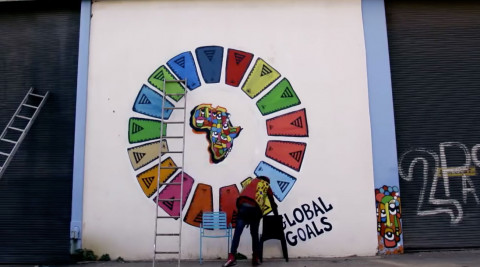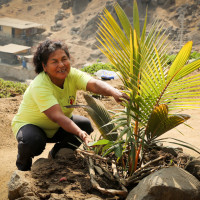Forward Motion against the Headwinds? Governance by Sustainable Development Goals
Topics
How do academics and researchers size up global goals to boost wellbeing worldwide?

project-everyone.org
Throwing light on the question above was a two-day conference at the University of Amsterdam (UvA) attended by several hundred university academicians, NGO staff, think-tank publicists and government officials. Entitled ‘Critical Perspectives on Governance by Sustainable Development Goals” the conference was a sequel to one held in 2016, also by the UvA’s Centre for Sustainable Development Studies (CSDS) bearing the same name, but lacking this year’s specific themes: water, food and climate.
Today, most events on the UN’s Sustainable Development Goals (SDGs) are meant to celebrate rather than question them. So it takes some chutzpah for an academic unit like the CSDS to run a show highlighting contrarian evidence and amplifying skeptical voices while powerful mainstream policymakers and funding agencies like to hear professions of faith and halleluiah choruses.
Indeed in some respects the SDGs are more about belief, and about singing from the same song-sheets than about making sure that the poor and excluded get tangible results. After all, there is no hard evidence that anti-poverty results pursued from 2000 to 2015 under the UN’s Millennium Development Goals (MDGs), could in fact be attributed to the MDGs amidst a myriad of other factors. The MDGs’ chief impacts were rather in structuring attention of policymakers and in adjusting budgets of some aid donors. In some cases, steering by the MDGs was positive, but in others negative. The MDGs diverted attention from fundamental matters like inequities, joblessness and disempowerment. Today, the SDGs have to some degree taken those matters on board, but in 2030 will things pan out any differently?
Sitting in on one of the conference’s four plenary sessions and four of its 31 panels, and talking with PhD students about research displayed on their posters, this blogger was left with the following fragmentary impressions:
First, university leaders broadly endorse the SDGs. At least, there was no real skepticism to be heard in remarks by four Dutch university rectors in the conference’s opening plenary. They talked about opportunities – not least, perhaps, opportunities to tap funds and other resources emerging as government and business show interest in being associated with SDGs – to enhance research, make connections, seek partnerships with governments, businesses, counterparts in the South and with other universities.
Only one of the rectors sounded a critical note when in a side remark he referred to the existence of ‘forum shopping’ among the SDGs. He was hinting at the many freedoms for powerful actors to pick and choose among targets, to earnestly endorse (never firmly commit to) some goals and to ignore the rest.
Second, among some academicians there is hearty skepticism about the SDGs. Despite their colossal range, the SDGs downplay or omit vital issues, or pose misleading interpretations. In her rousing talk in the conference’s opening plenary, “Scholarly Challenges to the SDGs”, UvA Professor Joyeeta Gupta laid out trendlines: consumption by richer people externalises ecosystem damage, chiefly to the detriment of poorer people’s wellbeing. Cross-subsidies might resolve perverse dynamic, but pro-poor cross subsidies are being cut back under austerity policies.
The implication: conventional frameworks guiding researchers are inadequate. Gupta’s powerful talk – which conference co-convenor Professor Maarten Bavinck termed a “double espresso” because it was so strong – was echoed elsewhere. In the panel on “SDGs and Common Justice in Latin America”, for example, the key question was: “Are SDGs a justification for business as usual or an opportunity for environmental justice in Latin America?” That panel’s convenor, Prof Barbara Hoogenboom, Director of CEDLA (Centre for Latin American Research and Documentation), added a note of scepticism by saying at the outset that SDGs were not a topic CEDLA works on; rather it focuses on such concrete processes as land use and politics.
Third, some knowledge producers are trying to wriggle free of old and often misleading concepts. They are probing processes driven by fast-moving ecological, economic, demographic and political factors that reinforce one another. Complexity is thus a by-word. Looming large among conceptual obstacles, noted in the panel on the “Food, water & energy nexus”, are notions of sovereign, autonomous nation-states. That bounded territorial framework – which raises touchy issues for the UN and other parts of global politics – can block understanding. Yet those boundaries were breached long ago by really existing processes that, say, connect food producers on one continent with food consumers on other continents.
As the workings of these much-ballyhooed global ‘value chains’ accelerate to satisfy demand in places of rising consumption, people in places of production face rising stress as their access to water and land diminish. Yet the means to grasp these transnational processes, and systematic data to build that understanding, are scarce. SDG-linked concepts and data for monitoring aren’t made to address that. More fundamentally, there is little clarity or even acknowledgement of ecological and socio-economic consequences of export-driven development model promoted under WTO-managed global trading system, as codified in SDG 17.
Several other panels, such as “Toward Inclusive water services” convened by UvA Professor Nicky Pouw, noted these conundrums and obstacles to improved understanding and policies. Perhaps in that sense Albert Hirschman’s 1970 arguments that making and adhering to paradigms can hinder understanding (echoed strongly today by Saskia Sassen, a globally-focused researcher) will have gotten more traction through this conference’s panels.
Fourth, while issues of governance, power and political economy were hardly the focal points of all panels, they were certainly foregrounded when it came to tackling matters of HOW the SDG targets are to be achieved. In her talk in the conference’s opening plenary, Professor Gupta, had questioned ‘Billions to Trillions’ slogan promoting private sector promises to close all gaps in development finance. This got further probing in the panel on “Illusions of Public-Private Partnerships”. The University College Dublin academic Siobhan Airey first sketched the contours of international governance today, noting the encroachments of ‘soft law’, technical rules and technocracies that enforce them, ‘multi-stakeholder’ forums and so forth.
All these trends are detectable today in the governance of the SDGs. National voluntary reporting, even by the Dutch government, is open to evasive practices. Then Brussels-based researcher Maria José Romero of Eurodad took the discussion further, sketching the surge in PPP projects since the turn of the century, and analyzing motivations (essentially risk reduction for banks and other businesses) and skewed consequences (socialization of risk and debt, privatization of reward) under conditions of poor transparency and public accountability and control.
From David Boys, Deputy General Secretary, of the trade union confederation Public Services International there came some telling observations about private sector involvement in key service branches, usually natural monopolies, such as water. “When you manage a monopoly for profit you will get distortions”. Coming out of Wall Street and the City today are proposals to pool PPP public debts to make them tradable assets. The financialization of PPPs may soon be at hand. Such developments would seem to outpace and overshadow the supposed open governance of SDGs, which is sometimes portrayed (misleadingly) in photographs of colourfully-clad people in earnest consultation in their tropical villages.
In conclusion, the conference made good on what its title promised by enabling critical perspectives to be shared. And it also allowed moments for alternatives to get some attention. A panelist referred, for example, to a neglected side of SDG indicator 17.1 on capacities to tax, namely the extent of tax avoidance. Indicators of tax shortfalls or of progress toward reducing revenue loss are not unfeasible.
Could such measures not be brought to the fore? No doubt in such panels as “diet transition”, “co-creating the circular city” and ” sustainable food production and consumption in Europe” (which this blogger did not attend) the feasibility of alternative designs and ways of governing were ventilated. Given the urgency of needs to deflect and tame the powerful headwinds against many SDGs -- the expanded reproduction of inequalities, dead-end working lives and post-democracy -- the need to widen and deepen attention to alternatives is evident. Might we look forward to a follow-up conference with a title like “Critical Alternatives in Governance by Sustainable Development Goals”?

